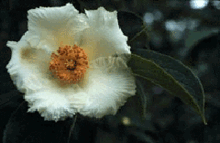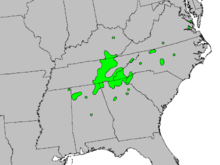Stewartia ovata
| Stewartia ovata | |
|---|---|
 | |
| Flower | |
| Scientific classification | |
| Kingdom: | Plantae |
| (unranked): | Angiosperms |
| (unranked): | Eudicots |
| (unranked): | Asterids |
| Order: | Ericales |
| Family: | Theaceae |
| Genus: | Stewartia |
| Species: | S. ovata |
| Binomial name | |
| Stewartia ovata (Cav.) Weatherby | |
 | |
| Range | |
Stewartia ovata, also Stuartia ovata, known commonly as Mountain Camellia, is a species of Stewartia native to low to mid-elevations in the southern Appalachian Mountains. A relative of the evergreen Camellias of Asia, other common names include summer dogwood and Mountain Stewartia.
Although not endangered, the plant does have a limited range and is considered to be rare. Mountain Camellia grows in the understory of predominately hardwood forests and tends to be found near streams, usually at elevations below 800 m (2,500 feet).
Description
Stewartia ovata is a deciduous flowering shrub or small tree growing to 5 m tall, with smooth, flaking grayish-orange bark. The leaves are oval with an acute apex, 7-13 cm long and 3-6 cm broad, and turn orange, red, or gold when the tree becomes dormant in the fall. The flowers are camellia-like, 6-12 cm diameter, with five white petals and numerous white, yellow or purple stamens; they appear in early to mid-summer.
- Varieties
There are two varieties:
- Stewartia ovata var. ovata — flowers 6-8 cm diameter, stamens white to yellow.
- Stewartia ovata var. grandiflora (W.J.Bean) Weatherby — flowers up to 12 cm diameter, stamens purple.
See also
References
External links
| Wikimedia Commons has media related to Stewartia ovata. |